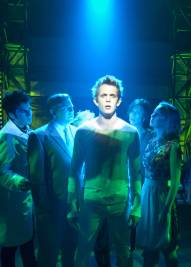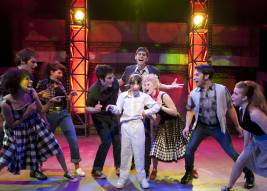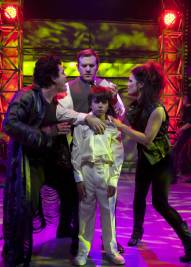
It’s not every day—or even every year—that an intimate theater production gets invited for a repeat engagement by a major Performing Arts Center. On the other hand, it’s not every year that an Orange County intimate theater production scores four Los Angeles Stage Alliance Ovation Award Nominations, wins a special Ovation Award for its spectacular video design, and is currently up for three Los Angeles Drama Critics Circle Awards, not to mention its nine Scenies including Best Intimate Theater Musical and Director Of The Year.
That’s why, as rare an occurrence as it may be, it makes perfect sense that the Segerstrom Center For The Arts is currently reprising The Chance Theater’s 49-seat production in its 250-seat Founders Hall—with stunning results.
The Chance Theater was tackling its most ambitious musical yet when it debuted its production of The Who’s Tommy last July. Under Oanh Nguyen’s inspired direction, the resulting production was quite possibly the Chance’s most thrilling musical ever, topping even the previous year’s Hair for visual and audio excitement. With state-of-the-art sound, lighting, and video design and a couldn’t-be-better cast, The Chance’s The Who’s Tommy (quite a mouthful) achieved the nearly impossible. It replicated the rock concert/rock theater experience in a 49-seat house. Spectacle and intimacy in equal measure—I couldn’t recall another show quite like it.
Now, less than six months after its initial, extended engagement, Tommy is back, bigger and better than ever, with all of its lead performers returning to the roles they created last summer and taking full advantage of the larger stage area offered the Segerstrom Center.
For post-Boomers, here’s a bit of Tommy background.
The Who’s Tommy began its life as a 1969 two-disk concept album by The Who, which spawned several Top 40 hits including “Pinball Wizard,” “I’m Free,” and “See Me, Feel Me.” Composed mostly by Pete Townshend and featuring vocals by Roger Daltrey, Tommy was the first musical work to bear the now oft-used (and abused) name “rock opera.” Ken Russell’s 1975 film version starred Daltrey as Tommy and Ann-Margaret as his mother, and the stage version being revived here debuted at the La Jolla Playhouse in 1993.
In Townshend and Des McAnuff’s book, 4-year old Tommy sees his father, just returned from World War II imprisonment, shoot and kill Mrs. Walker’s lover, and goes “deaf, dumb, and blind” (though it is not until he turns 10 that he “sure plays a mean pinball.”) Tommy (The Rock Opera) follows Tommy’s journey through life, his celebrity as a “Pinball Wizard,” the eventual recovery of his sight, and his ultimate embracing of a normal family life.
Narrating Tommy’s story (and becoming Tommy himself in Act Two) is a terrific Mark Bartlett, combining looks and charisma aplenty with just the right rock pipes to do justice to Daltrey’s original vocals. Bartlett is a Cal State Fullerton BFA student, and in fact, a number of other members of Tommy’s cast of eighteen are either currently enrolled in (or recent graduates of) musical theater programs at some of the Southland’s finest training grounds. The result is a production with the same youthful verve that has made Green Day’s American Idiot one of Broadway most talked about current hits. At the same time, by casting the show’s older roles with age-appropriate actors, Nguyen avoids the “student production” feel that cast-too-young musicals can suffer from. This is musical theater at its most professional, and a production that can stand up against the best Broadway has to offer, albeit on a somewhat smaller scale.
The adults in the company are Wendi Ann Hammock (Mrs. Walker), Kevin Cordova (Captain Walker), and Beach Vickers (Uncle Ernie), and they are all three splendid. Hammock and Cordova both have the vocal power and gravitas that their roles require, and an equally strong-voiced Vickers is a hoot as dirty Uncle Ernie, his pedophilic “Fiddle About” alternately hilarious and squirm-inducing.
In four of the show’s most thrilling performances, Paul Hovannes is a dynamic Cousin Kevin, his rendition of “Pinball Wizard” as thrilling as the best of them, Miguel Cardenas (Hawker) belts out a bluesy “Eyesight To The Blind,” Kyle Cooper (Specialist) shows of his own killer pipes in “Go To The Mirror Boy,” and Louis Pardo makes for an exciting Lover in “Twenty One.”
Among the ladies, there’s Chance Company Member Clarissa Barton adding her name to the illustrious list of divas who’ve sung “Acid Queen” (Patti LaBelle, Bette Midler and Tina Turner, to name just three) and giving the role her all. Brynne McManimie stands out too as Tommy groupie Sally Simpson as does Liz Holt as Harmonica Player. Then there are the kids, 6-year-old Cameron McIntyre as Tommy Age 4 and 9-year-old Seth Dusky as Tommy Age 10, both as cute as can be. Completing the stellar ensemble are Alex Bueno, Israel Cortez, Dan Flapper, Elena Murray, and Kellie Spill, who work harder than just about any group of triple-threats on stage this winter.
Kelly Todd takes over choreographic duties from LADCC nominee Allison Bibicoff, and like her predecessor keeps cast members almost constantly in motion to the music, that is when their multiple-role tracks haven’t sent them quickly offstage to change costumes again and again and again. The combination of 1940s, ’50s, and ‘60s costumes and Todd’s exciting, contemporary choreography make for a heady mix.
Musical director Mike Wilkins on piano and keyboard and his stupendous backup band, one member larger than the original production’s, with Stephen Musselman and Chris Lueback on 1st and 2nd guitars, Robert Bowman on bass, and Jorge Zuniga on drums, sound like twice times that many as amplified to rock concert perfection by sound designer Casey Long.
Christopher Scott Murillo’s first-rate set design replicates the rock concert look Tommy needs, this time round on a considerably larger scale, and Erika C. Miller’s costumes are a dazzling blend of eras and styles, complemented by Julie Wilkins’ trendy hair and makeup design.
Finally there is KC Wilkerson’s lighting and his multiple award-winning video design, not only his best ever, but one of the most breathtaking blends of lights and video projections I can recall seeing.
Tanae Beyer is stage manager, Robert Hahn assistant choreographer, and Chance Dean fight choreographer.
When you realize that the 20somethings who first rocked out to The Who’s Tommy are now (like Townsend and Daltrey) in their mid sixties, there’s hardly a theatergoer too old for Tommy, and with a cast of early-20somethings on stage, this is a show that’s right for anyone old enough to appreciate rock music.
The Chance is has no equal in Orange County intimate theater, and thanks to the Segerstrom Center’s oh-so-savvy programming decision, the brilliance of Oanh Nguyen and company will now reach an even larger audience. As they did last summer, The Chance’s The Who’s Tommy has blown away the competition with a spectacular feat of theatrical entertainment.
Note to ticket buyers: Rows B, D, and F at Founders Hall are at the very same level as the row of seats in front of them. Ticket buyers are advised to request not to be seated in rows B, D, and F.
Segerstrom Center For The Arts, Founders Hall, 600 Town Center Drive, Costa Mesa.
www.scfta.org
www.chancetheater.com
–Steven Stanley
February 10, 2011
Photos: Doug Catiller, True Image Studio





 Since 2007, Steven Stanley's StageSceneLA.com has spotlighted the best in Southern California theater via reviews, interviews, and its annual StageSceneLA Scenies.
Since 2007, Steven Stanley's StageSceneLA.com has spotlighted the best in Southern California theater via reviews, interviews, and its annual StageSceneLA Scenies.







 COPYRIGHT 2024 STEVEN STANLEY :: DESIGN BY
COPYRIGHT 2024 STEVEN STANLEY :: DESIGN BY